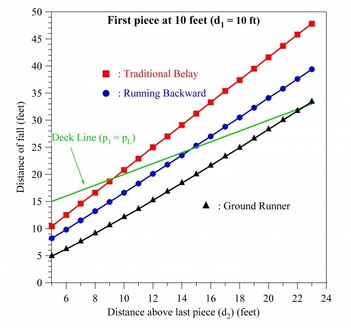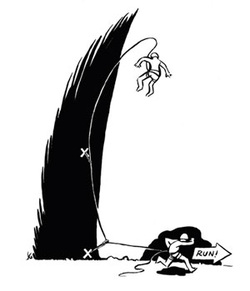How it Works

Diagram from Adam Sheer at ClimbingHouse.com
Here's the scenario:
Tom has clipped into the first bolt 15 feet off the deck. The next bolt is 35 feet off the deck. Simple logic tells me that if he falls in the last 5 feet before that last bolt, he's going to hit the deck. While reaching to make the second clip, his foot slips and he pitches off the face. With a traditional belay, he would hit the deck in no time (get out of the splatter path!). If the belayer simply runs backward, he still would probably hit the deck (Great job! By running you got out of the splatter path, but not much more!). If the belayer had thought ahead and installed a Ground Runner Belay and planned a run path, the climber would be dangling a few inches off the deck. Urine in the pants, but not a pancake. The belayer may be a bit roughed up after being jerked backward from the falling climber's force, but hopefully nothing worse than a few scratches or a sprained ankle.
Alright, now that we've hopefully scared you into never finding yourself in a position where this will be necessary, here's what you do:
Tom has clipped into the first bolt 15 feet off the deck. The next bolt is 35 feet off the deck. Simple logic tells me that if he falls in the last 5 feet before that last bolt, he's going to hit the deck. While reaching to make the second clip, his foot slips and he pitches off the face. With a traditional belay, he would hit the deck in no time (get out of the splatter path!). If the belayer simply runs backward, he still would probably hit the deck (Great job! By running you got out of the splatter path, but not much more!). If the belayer had thought ahead and installed a Ground Runner Belay and planned a run path, the climber would be dangling a few inches off the deck. Urine in the pants, but not a pancake. The belayer may be a bit roughed up after being jerked backward from the falling climber's force, but hopefully nothing worse than a few scratches or a sprained ankle.
Alright, now that we've hopefully scared you into never finding yourself in a position where this will be necessary, here's what you do:
- Build yourself an anchor at the base of the climb that is directionally bomber for both upward and outward force. You will probably have to use active or passive pro to build this anchor, but you may find a fixed bolt for this exact purpose or be able to use a large boulder or tree. Attach a runner and a locker to the anchor and pass the rope through this as if it were the first bolt on the climb (see above diagram).
- Inspect the surrounding area for a safe run path. Where will you sprint in the event of a fall? Pick a B line with no serious hazards. You're surrounded by jagged rocks, fire breathing dragons, and the edge of a cliff? Abandon the climb - it's not worth it.
- Put on your helmets - both of you.
- If the climber takes a fall from a deck-hitting (or ledge-hitting) position (i.e. > 2x the distance above his/her last piece), sprint away from the wall through your pre-determined run path.
- When the climber's weight (hopefully) falls onto his/her last piece of pro, you (the belayer) will be violently jerked backward. Hopefully you have both survived.
Why it's the best technique for this scenario (see above diagram)
- The belayer pulls in more slack than with a traditional belay or a standard run from the cliff belay. In the run from the cliff scenario (no ground runner), the belayer pulls slack at a diagonal rather than in a direct line - much less efficient.
- The ground runner keeps the rope low and out of the fall path. In the run from the cliff belay, the climber is also in danger of hitting the diagonal (higher) rope. Think: rope burn!
- The ground runner also ensures that downward force is applied to the first piece of pro. This is especially important if you are utilizing this in traditional climbing where pieces are directional. In the run from the cliff belay, the force on the first piece of pro is applied outward, which could greatly compromise any nut or cam placement.
Check out ClimbingHouse.com for Adam Sheer's much more thorough description of this technique - prepare to geek out on the physics of taking a leader fall!

